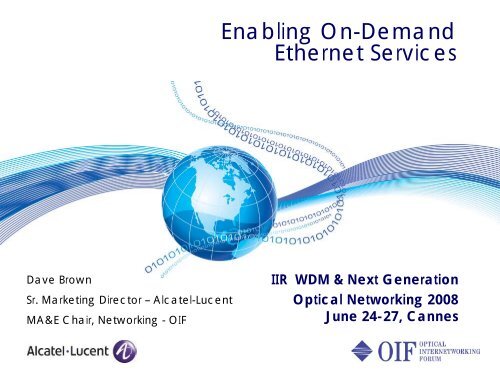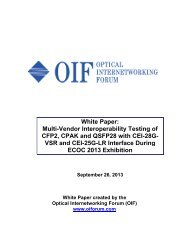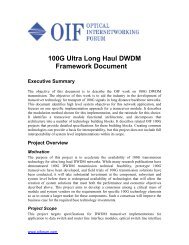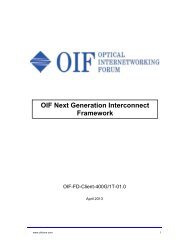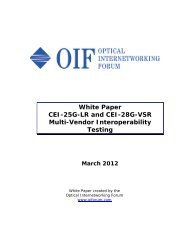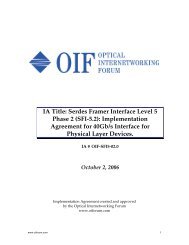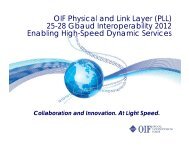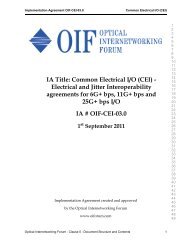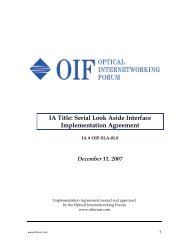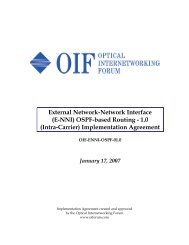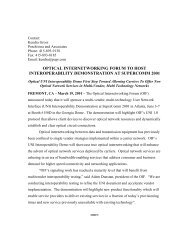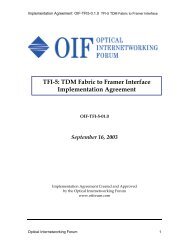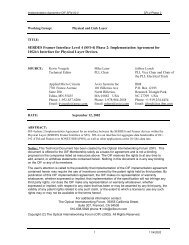Enabling On-Demand Ethernet Services - OIF
Enabling On-Demand Ethernet Services - OIF
Enabling On-Demand Ethernet Services - OIF
Create successful ePaper yourself
Turn your PDF publications into a flip-book with our unique Google optimized e-Paper software.
<strong>Enabling</strong> <strong>On</strong>-<strong>Demand</strong><strong>Ethernet</strong> <strong>Services</strong>Dave BrownSr. Marketing Director – Alcatel-LucentMA&E Chair, Networking - <strong>OIF</strong>IIR WDM & Next GenerationOptical Networking 2008June 24-27, Cannes
About the <strong>OIF</strong>Mission: to foster, progress and guide the development anddeployment of interoperable products and services fortransport networks.The <strong>OIF</strong> is the only industry group that brings togetherprofessionals from the data and optical worldsOur 80+ member companies represent the entire industryecosystem:• Carriers and network users• Component and systems vendors• Testing and software companiesCollaboration and Innovation. At Light Speed.
Market Drivers for Interoperable NetworksMarket Trend/Needs Carriers face growing demand forhigh-speed, flexible, and highlyresilient transport services – regionallyand globallyCarrier Challenges Deliver end-to-end services acrossmultiple network domains• while maintaining resilience• and meeting customerexpectations (SLAs)The Need/Gap Interoperable networks that cansupport cost-effective dynamicbandwidth services - on a global scaleWhat is the Solution?
<strong>OIF</strong> Worldwide Interoperability DemonstrationEnd-to-end provisioning of dynamicswitched <strong>Ethernet</strong> services• Over multiple control planeenabledintelligent optical corenetworks• Using <strong>OIF</strong> UNI 2.0 and <strong>OIF</strong> E-NNIImplementation AgreementsSupported by (7) major Carriers and(8) leading equipment vendors fromAsia, Europe and the USATesting conducted in Carrier labsJune – Sept 2007<strong>On</strong>-<strong>Demand</strong> <strong>Ethernet</strong> <strong>Services</strong> across Global Networks
Putting the Pieces Together<strong>OIF</strong> Implementation Agreements and Interoperability DemosUNI 1.0 signaling<strong>OIF</strong> Implementation AgreementsUNI 1.0r2 signalingE-NNI 1.0 signalingE-NNI 1.0 routingE-NNI 2.0 signaling(in process)UNI 2.0 signaling2001 2002 2003 2004 2005 2006 20072008Lab LocationUNHUNHGlobal – 7 carriersGlobal – 7 carriersGlobal – 7 carriersTrade ShowSUPERCOMMOFCSUPERCOMMSUPERCOMMECOCNewCapabilitiesTestedDraft UNI 1.0Draft E-NNIsignalingand routingCP-enabled SONET/SDH data plane<strong>Ethernet</strong> overSONET/SDH dataplane-only test(GFP/VCAT/LCAS)Draft extensionsfor controlplane-enabledEPLData plane-onlytest of EVPL andELANPre-IA UNI 2.0 and E-NNI 2.0 signalingControl plane failurerecoveryBW modificationControl plane neighbordiscovery<strong>OIF</strong> Networking Interoperability Demonstrations
Key Aspects of the DemoStandards-based solutions – to easetransition from the lab to networkdeploymentInterconnected and interoperableheterogeneous network equipment –from leading vendors• At the data plane level betweenMSPPs, routers, <strong>Ethernet</strong> switches,cross-connects and OADMs• At the control plane betweenembedded and proxy controllersInvolvement of major global carriers– shows commitment and visionRealizing Interoperability in Global Optical Networks
Demo Set-Up and Topology• Heterogeneous multi-vendor and multi-domain networks with ASON/GMPLSenablednodes and domains•Interconnected via an <strong>OIF</strong> control plane with inter-domain links and supported bya global SCNUSA Europe AsiaAlcatel-LucentAT&TCienaSycamoreAlcatel-LucentVerizonCienaMarbenTellabsAlcatel-LucentMarbenTIEricssonEricssonHuaweiHuaweiDTSycamoreEricssonUNI linkClient nodeMarbenCienaFTMarbenSycamoreE-NNI linkNetwork nodeEricssonMarbenZTE/CienaZTEHuaweiKDDICT
Demo Technology and FeaturesEnd-to-end provisioning of dynamic switched <strong>Ethernet</strong>servicesOver multiple, control plane-enabled intelligent optical corenetworksUsing <strong>OIF</strong> UNI 2.0 and <strong>OIF</strong> E-NNI IAsFeaturing:• <strong>Ethernet</strong> Private Line Service• Control Plane Neighbor Discovery• Non-Disruptive Bandwidth Modification• Control Plane Failure Recovery
<strong>Ethernet</strong> <strong>Services</strong><strong>Ethernet</strong>ClientCarrier ADomainCarrier BDomainCarrier CDomain<strong>OIF</strong> UNI <strong>OIF</strong> E-NNI <strong>OIF</strong> E-NNI<strong>OIF</strong> UNINE NE NE NE NE NE<strong>Ethernet</strong>Client<strong>Ethernet</strong>SONET/SDH<strong>Ethernet</strong> Virtual Circuit (EVC)<strong>Ethernet</strong>The Metro <strong>Ethernet</strong> Forum (MEF) classifies <strong>Ethernet</strong> services as E-Line (point topoint) and E-LAN (multipoint to multipoint). E-Line can be further divided into:• <strong>Ethernet</strong> Private Line (EPL), where an <strong>Ethernet</strong> port has dedicatedbandwidth across a provider network (no service multiplexing)• <strong>Ethernet</strong> Virtual Private Line (EVPL), where multiple <strong>Ethernet</strong> ports sharebandwidth across a provider network (service multiplexing)<strong>OIF</strong> UNI 2.0 supports both EPL and EVPL servicesThe demonstration focuses on interoperable on-demand <strong>Ethernet</strong> <strong>Services</strong>,offered under the ITU-T Recommendation G.8011.1 EPL model.
<strong>OIF</strong> Multi-Layer Call Control<strong>Ethernet</strong>ClientCarrier ADomainCarrier BDomainCarrier CDomain<strong>OIF</strong> UNI <strong>OIF</strong> E-NNI <strong>OIF</strong> E-NNI<strong>OIF</strong> UNINE NE NE NE NE NE<strong>Ethernet</strong>Client<strong>Ethernet</strong>SONET/SDH<strong>Ethernet</strong>UNI-CUNI-N<strong>Ethernet</strong> Layer Call ControlUNI-NUNI-CVCAT Layer Call ControlSONET/SDH Layer Call ControlActions are coordinated between call controllers at each layer• VCAT treated as a separate layer, to allow control and sequencing of VCG members• Traffic parameters are tailored to each layerThese techniques can be applied to other layers besides <strong>Ethernet</strong>/VCAT/SONET-SDH
Control Plane Neighbor DiscoveryControlPlaneOut-of-band messagesOut-of-band messagesTransportPlaneIn-band (J0)messageIn-band (J0)message Discovery is a dynamic exchange of information for links brought into service –replacing manual configuration with automated “plug and play”• In-band overhead bytes (J0) describe local transport and control plane resources• Control plane entity correlates local and remote node information In-band message formats (such as Layer Adjacency) have been defined in ITU-T.• The <strong>OIF</strong> demo extended this capability with out-of-band messages for exchangingdiscovered information (a Layer Adjacency Discovery response message)• Discovery was also extended to exchange control plane information, such asidentifiers of control plane and transport plane entities, and routing area information• Results of demo should assist future discovery standards development
Non-Disruptive Bandwidth Modificationa) Set up 300 Mbit/s b) Increase BWconnection to 450 Mbit/s<strong>Ethernet</strong>Carrier AClientDomainCarrier BDomainCarrier CDomain<strong>OIF</strong> UNI <strong>OIF</strong> E-NNI <strong>OIF</strong> E-NNI<strong>OIF</strong> UNINE NE NE NE NE NE<strong>Ethernet</strong>Client<strong>Ethernet</strong>SONET/SDH<strong>Ethernet</strong>UNI-CUNI-N<strong>Ethernet</strong> Layerb) a) 450 300 Mbit/sUNI-NUNI-CVCAT Layerb)a)VCGVCGMembersMembersA,A,B,BCSONET/SDH Layera) Two VC-4 Connectionsb) Three VC-4 ConnectionsBandwidth modification adjusts connection capacity to meet elastic demand• Enables carrier to “right-size” client <strong>Ethernet</strong> BW using legacy SONET/SDH network• Clients use/billed for only what they need• Network utilization is optimized
Recovery From Control Plane FailureControlPlaneXHello HelloControl planeadjacencies- Control plane adjacencyand connection statesrestored after recovery- Control and transportplane topologies may differ- Connections unaffected bycontrol plane failureTransport planeconnectionsTransportPlaneControl plane failure recovery is a key carrier-class resiliency feature• Existing connections not affected by control plane failure (ASON requirement)• Applies to control plane link or node failure
<strong>OIF</strong> and SDOs Working TogetherSupporting <strong>Ethernet</strong> <strong>Services</strong> across a Global Transport NetworkRecommendationsASON Architecture &GMPLSRequirementsProtocolsInterop ResultsASON/GMPLS E-NNI, UNIIETFRFCsControlPlaneMgmt.TMFSolution Sets<strong>Ethernet</strong><strong>Services</strong>Use CasesSignalling for<strong>Ethernet</strong> <strong>Services</strong>ImplementationAgreementsTechnicalSpecifications
Opportunities Enabled byInteroperability for Network Users<strong>On</strong>-demand data service provisioning on national and globalscaleBandwidth optimization• Map <strong>Ethernet</strong> efficiently to SONET/SDH payload cost efficient• Dynamic SONET/SDH bandwidth allocation according to <strong>Ethernet</strong>usage cost efficient• In-Service bandwidth adjustment at any time network userdirectedGlobal coverage of data services, based on SONET/SDH networksProvides high reliability based on multiple resilience mechanisms
Opportunities Enabled byInteroperability for System VendorsVendors are committed to prove that their implementation arecompliant with standards and interoperableVendors foster deployment of new data services by providinginteroperable solutionsInteroperability of vendor network domains is a precondition forglobal coverage of network servicesInteroperability eases system integration of different vendorsolutions and therefore opens market opportunities for <strong>Ethernet</strong>,SONET/SDH, OTN and other equipment
Opportunities Enabled byInteroperability for CarriersCarriers can provision end-to-end dynamic connections forflexible data services over multiple, control plane enabledtransport domainsCarriers can deploy at faster pace innovative networktechnologiesCarriers are enabled to select cost effective and innovativenetwork elements, platforms and multi-vendor solutionsCarriers are enabled to reduce operations overhead and simplifyprovisioning of new services
ConclusionDelivering <strong>Ethernet</strong> services over intelligent optical transportnetworks: Enables cost-effective end-to-end transport of high-speeddata Leverages embedded transport infrastructure Allows Carriers to selectively upgrade their networks toenable dynamic bandwidth services Accelerates time-to-market, service provisioning, andrevenue generation Maintains carrier-grade reliability and customer satisfaction<strong>OIF</strong> Worldwide Interop Demo White Paper
Thank You!For more information on the <strong>OIF</strong> please visit:http://www.oiforum.com


